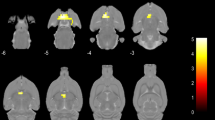Abstract
The aim of the present study was to investigate the status of jejunal absorption and peripheral metabolism of glucose in Wistar Audiogenic Rats (WAR), a genetic model of epilepsy, after seizures induced by intensive sound exposure. The jejunal loop of rats was isolated and infused (0.5 mL min−1) with Tyrode solution containing twice the normal concentrations of glucose, sodium, and potassium. Samples were taken at 5 or 10-min intervals over a 40-min period. At the end of the experiment, samples of liver and gastrocnemius muscle were taken to measure the levels of glycogen, glucose-6-phosphate, fructose-6-phosphate and glucose transporter-4 (GLUT4). Hepatic glucose-6-phosphate increased in WAR submitted to audiogenic seizure (21.90 ± 3.08) as compared to non-susceptible Wistar rats (8.12 ± 0.87) and to WAR not submitted to audiogenic stimulation (5.17 ± 0.97). In addition, an increase in hepatic fructose-6-phosphate, an intermediate metabolite of the glycolytic pathway, was observed in WAR submitted to audiogenic seizure (5.98 ± 0.99) compared to non-susceptible Wistar rats (2.38 ± 0.53). According to the present results, jejunal absorption of glucose was not changed by seizures. However, generalized tonic–clonic seizures produced by sound stimulation resulted in a decrease in muscle glycogen content. In addition, our results demonstrated that the concentration of GLUT4 in the gastrocnemius muscle of WAR was 1.6-fold higher than that observed in resistant rats and that the audiogenic stimulus led to decreased concentration of this receptor in the muscle of WAR animals.





Similar content being viewed by others
References
Bernard-Helary K, Lapouble E, Ardourel M, Hévor T, Cloix JF (2000) Correlation between brain glycogen and convulsive state in mice submitted to methionine sulfoximine. Life Sci 67(14):173–181
Borges EL, Braga AA, Petroianu A (1998) Influence of obstructive jaundice on jejunal absorption of glucose, electrolytes, and vitamin A in rats. Dig Dis Sci 43(10):2196–2200
Botion LM, Doretto MC (2003) Changes in peripheral energy metabolism during audiogenic seizures in rats. Physiol Behav 78(4–5):535–541
Danforth WH (1965) Glycogen synthetase activity in skeletal muscle interconversion of two forms and control of glycogen synthesis. J Biol Chem 240(2):588–593
Doretto MC, Fonseca CG, Lobo RB, Terra VC, Oliveira JAC, Garcia-Cairasco N (2003) Quantitatitive study of the response to genetic selection of the Wistar Audiogenic Rat strain (WAR). Behav Genet 33(1):33–42
Ferrer JC, Favre C, Gomis RR, Fernández-Novell JM, García-Rocha M, Iglésia N, Emili C, Guinovart JJ (2003) Control of glycogen deposition (Minireview). Fed Europ Biochem Soc Let 546(1):127–132
Folbergrová J (1995) Glycogen phosphorylase activity in the cerebral cortex of rats during development: effect of homocysteine-induced seizures. Brain Res 694(1–2):128–132
Folbergrová J, Haugvicová R, Mareš P (2000) Behavioral and metabolic changes in immature rats during seizures induced by homocysteic acid: the protective effect of NMDA and non-NMDA receptor antagonists. Exp Neurol 161(1):336–345
Folbergrová J, Druga R, Otáhal J, Haugvicová R, Mareš P, Kubová H (2005) Seizures induced in immature rats by homocysteic acid and the associated brain damage are prevented by group II metabotropic glutamate receptor agonist (2R,4R)-4-aminopyrrolidine-2,4-dicarboxylate. Exp Neurol 192(2):420–436
Garcia-Cairasco N, Wakamatsu H, Oliveira JAC, Gomes ELT, Del Bel EA, Mello LEAM (1996) Neuroethological and morphological (Neo–Timm staining) correlates of limbic recruitment during the development of audiogenic kindling in seizure susceptible Wistar rats. Epilepsy Res 26(1):177–192
Goodyear LJ, Hirshman MF, King PA, Horton ED, Thompson CM, Horton ES (1990) Skeletal muscle plasma membrane glucose transport and glucose transporters after exercise. J Appl Physiol 68(1):193–198
Hassid WZ, Abraham S (1957) Determination of glycogen with anthrone reagent. Methods Enzymol 3:35–36
Hevor TK, Delorme P, Beauvillain JC (1986) Glycogen synthesis and immunocytochemical study of fructose 1,6-biphosphatase in methionine sulfoximine epileptogenic rodent brain. J Cereb Blood Flow Metab 6(3):292–297
Hevor TK, Aissi E, Delorme P (1990) Correlation between carbohydrate and catecholamine level impairments in methionine sulfoximine epileptogenic rat brain. Neurochem Res 15(9):861–868
Hohorst HJ (1973) D-glucose-6-phospate and D-fructose-6-phosphate determination with glucose-6-phospate dehydrogenase and phosphoglucose isomerase. In: Bergmeyer HV (ed) Methods of enzymatic analysis. Academic, New York, pp 134–139
Ingvar M, Söoderfeldt B, Folbergrová J, Kalimo H, Olsson Y, Siesjö BK (1984) Metabolic, circulatory, and structural alterations in the rat brain induced by sustained pentylenetetrazole seizures. Epilepsia 25(2):191–204
Klip A, Pâquet MR (1990) Glucose transport and glucose transporters in muscle and their metabolic regulation. Diabetes Care 13(3):228–243
Maehlum S, Hermansen L (1978) Muscle glycogen concentration during recovery after prolonged severe exercise in fasting subjects. Scand J Clin Lab Invest 38(6):557–560
Michelson-Kerman M, Watemberg N, Nissenkorn A, Gilad E, Sadeh M, Lerman-Sagie T (2003) Muscle glycogen depletion and increased oxidative phosphorylation following status epilepticus. J Child Neurol 18(12):876–878
Roach PR (2002) Glycogen and its metabolism. Current Molecular Medicine 2(2):101–120
Sakurai K, Kawazuma M, Adachi T, Harigaya T, Saito Y, Hashimoto N, Mori C (2004) Bisphenol A affects glucose transport in mouse 3T3-F442A adipocytes. Brit J Pharmacol 141(2):209–214
Shulman RG, Rothman DL (2001) The “glycogen shunt” in exercising muscle: A role for glycogen in muscle energetics and fatigue. Proc Natl Acad Sci U S A 98(2):457–461
Acknowledgements
We would like to thank Dr. Cândido Celso Coimbra for helpful advice and Dr Frederic Jean Georges Frezard for English revision. Fernanda K. S. Pereira was the recipient of a CNPq fellowship.
Author information
Authors and Affiliations
Corresponding author
Rights and permissions
About this article
Cite this article
Pereira, F.K.S., Neves, M.J., Lima, M.P. et al. Peripheral glucose metabolism is altered by epileptic seizures. Metab Brain Dis 23, 105–114 (2008). https://doi.org/10.1007/s11011-007-9075-0
Received:
Accepted:
Published:
Issue Date:
DOI: https://doi.org/10.1007/s11011-007-9075-0




